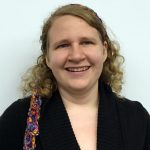
This Forum Update was provided by Megan Browndorf, Research and Instruction Librarian, Albert S. Cook Library, Towson University.
For me, day two was all about collaboration and communication. The powers of talking, sharing, and combining our powers into something bigger and better than what we can do alone.
My day started with a session on “Big Collections in an Era of Big Copyright.” While exploring how to navigate copyright issues in large collections of digitized items, such as those of the Hathi Trust, the Digital Public Library of America (DPLA), or Europeana, the panel talked about clarifying the fuzzy space between public domain and various states of licensure. The methods that these institutions are using to streamline copyright clearance and make sense of hundreds of different rights statements is based deeply in collaboration. The only way to balance the technical, legal, and social peculiarities of copyright clearance is to pull together very different groups of people as well as larger groups of stakeholders. Indeed, the Copyright Review Management System at the University of Michigan is bringing all these groups together in a fascinating attempt to speed up the copyright clearance process for digital materials.
The next session on “Experimental Scholarly Publishing” turned the collaboration and communication themes up to 11. The session discussed different ways that scholars and practitioners are attempting to curate relevant disciplinary output for their communities. As a regular reader of both Digital Humanities Now and dh+lib, it was a delight to hear about the thought processes that go into two of my favorite RSS feeds. One thing was clear from this session – the future way that scholars will communicate new and relevant information will look different than the way to which they have long been accustomed and the way that I regularly teach them in the classroom. I had two thoughts while attending this session. First, could I use something like Press Forward and a curation-based approach to scholarly reading in my instruction; and second, how will I teach students to approach something like the Public Philosophy Journal in their research? Really, if the answer to the former question is “yes,” that might be the answer to the latter question.
The session I was most excited to attend was the one on Digital Public History. As a History Librarian at Towson University, a state institution, I encourage my students to use Digital Public History projects regularly. Students are engaged by primary sources related to their lives and the world around them, which is why I love encouraging my Baltimore-area students to use projects as large as Digital Maryland and as narrow as Baltimore ’68: Riots and Rebirths. Finding new resources always makes me happy, but thankfully this session went beyond that. Like many of the sessions I’ve attended, there were approximately twice as many people on stage as there were presentations, pointing directly to what I’ve been feeling all day – that collaboration is the bread and butter of making these types of projects work.
And this is not just collaboration with other professionals, but with users, students, and the general public. Based on the success of their DIY History project that used off-campus volunteers to perform transcription work, the University of Iowa’s ArchivesAlive! lesson plans engaged undergraduate students in history through transcription work. UCLA’s “SoLoGlo,” or Social Local Global approach to their projects similarly leveraged local students and talent to examine larger collections, in this case global collections of activist tweets and videos. Convincing students to think about digital history as part of their research and to deeply engage primary sources is integral to my teaching. This session convinced me that if I really want them to engage with this content, my students also need to be content creators.
The last session I attended on User Experience Design (UX) at Stanford University Libraries examined some of the “challenges” of collaborative design, specifically avoiding “design by committee” and reconciling differences between different designers. However, on the whole the session underscored a need for collaboration and a desire to move beyond simple user feedback, toward user involvement. While this was not something that related directly to my everyday experiences as a librarian, the idea of orienting toward the user-community echoes a movement throughout academic library departments. This approach to UX – combining IT expertise, public services expertise, subject expertise, and any other specialized knowledge – is applicable in public services, instruction, technical services, as well as the digital library world.
And there’s that word, “expertise” again! As Nowviskie charged me to do, during her keynote, I have to ask: What is the purpose of expertise in the UX experience, in scholarly communication, in public history, in copyright issues? Ultimately, it seems that expertise is at its most useful in all of these cases in concert with other forms of expertise. It is so that we can approach something big-picture in a deeper fashion by pulling all of this expertise together through purposeful and thoughtful collaboration and communication.
